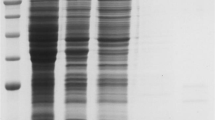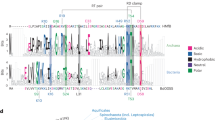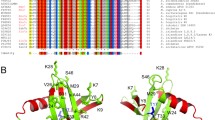Abstract
The complete genome analysis of the archaeon Thermoplasma volcanium has revealed a gene assigned to encode the histone-like DNA-binding protein HU. Thermoplasma volcanium is a moderate thermophile growing around 60°C and it is adaptable to aerobic and anaerobic environment and therefore it is unique as a candidate for the origin of eukaryotic nuclei in the endosymbiosis hypothesis. The HU protein is the major component of the bacterial nuclei and therefore it is an important protein to be studied. The gene for HUTvo protein (huptvo) was cloned from the genomic DNA of T. volcanium and overexpressed in Escherichia coli. A fast and efficient purification scheme was established to produce an adequate amount of bioactive protein for biochemical and biophysical studies. Highly purified HUTvo was studied for its DNA-binding activity and thermostability. As studied by circular dichroism and high-precision differential scanning microcalorimetry, the thermal unfolding of HUTvo protein is reversible and can be well described by a two-state model with dissociation of the native dimeric state into denatured monomers. The ∆G versus T profile for HUTvo compared to the hyperthermophilic marine eubacterial counterpart from Thermotoga maritima, HUTmar, clearly shows that the archaeal protein has adopted a less efficient molecular mechanism to cope with high temperature. The molecular basis of this phenomenon is discussed.




Similar content being viewed by others
References
Benitez-Cardoza CG, Rojo-Dominguez A, Hernandez-Arana A (2001) Temperature-induced denaturation and renaturation of triosephosphate isomerase from Saccharomyces cerevisiae: evidence of dimerization coupled to refolding of the thermally unfolded protein. Biochemistry 40:9049–9058
Boelens R, Vis H, Vorgias CE, Wilson KS, Kaptein R (1996) Structure and dynamics of the DNA binding protein HU from Bacillus stearothermophilus by NMR spectroscopy. Biopolymers 40:553–559
Bohm G, Muhr R, Jaenicke R (1992) Quantitative analysis of protein far UV circular dichroism spectra by neural networks. Protein Eng 5:191–195
Bradford M (1976) A rapid and sensitive method for the determination of microgram quantities of protein utilising the principle of protein–dye binding. Anal Biochem 72:248–254
Castaing BC, Zelwer C, Laval J, Boiteux S (1995) HU protein of Escherichia coli binds specifically to DNA that contains single-strand breaks or gaps. J Biol Chem 270:10291–10296
Christodoulou E, Rypniewski W, Vorgias CE (2003) High resolution X-ray structure of the DNA binding protein HU from the hyperthermophilic eubacterium Thermotoga maritima and the determinants of its thermostability. Extremophiles 7:111–122
Christodoulou E, Vorgias CE (2002) The thermostability of the DNA binding protein HU from mesophilic thermophilic and extreme thermophilic bacteria. Extremophiles 6:21–31
Coste F, Hervouet N, Oberto J, Zelwer C, Castaing B (1999) Crystallization and preliminary X-ray diffraction analysis of the homodimeric form alpha2 of the HU protein from Escherichia coli. Acta Crystallogr Biol Crystallogr D55:1952–1954
Damodaran S (2003) In situ measurement of conformational changes in proteins at liquid interfaces by circular dichroism spectroscopy. Anal Bioanal Chem 376:182–188
DeLano WL (2002) The PyMOL molecular graphics system on world wide web. http://www.pymol.org
Drlica K, Rouviere-Yaniv J (1987) Histonelike proteins of bacteria. Microbiol Rev 51:301–319
Durney MA, Wechselberger RW, Kalodimos CG, Kaptein R, Vorgias CE, Boelen R (2004) An alternate conformation of the hyperthermostable HU protein from Thermotoga maritima has unexpectedly high flexibility. FEBS Lett 563:49–54
Esser D, Rudolph R, Jaenicke R, Bohm G (1999) The HU protein from Thermotoga maritima: recombinant expression, purification and physicochemical characterization of an extremely hyperthermophilic DNA-binding protein. J Mol Biol 291:1135–1146
Futterer O, Angelov A, Liesegang H, Gottschalk G, Schleper C, Schepers B, Dock C, Antranikian G, Liebl W (2004) Genome sequence of Picrophilus torridus and its implications for life around pH 0. Proc Natl Acad Sci USA 101:9091–9096
Gill CS, von Hippel PH (1989) Calculation of protein extinction coefficients from amino acid sequence data. Anal Biochem 182:319–326
Gouet P, Courcelle E, Stuart DI, Metoz F (1999) ESPript: multiple sequence alignments in PostScript. Bioinformatics 15:305–308
Greenfield NJ (1996) Methods to estimate the conformation of proteins and polypeptides from circular dichroism data. Anal Biochem 235:1–10
Guex N, Peitsch MC (1997) SWISS-MODEL and the Swiss-PdbViewer: an environment for comparative protein modeling. Electrophoresis 18:2714–2723
Hilser VJ, Townsend BD, Freire E (1997) Structure-based statistical thermodynamic analysis of T4 lysozyme mutants: structural mapping of cooperative interactions. Biophys Chem 64:69–79
Hwang DS, Kornberg A (1992) Opening of the replication origin of Escherichia coli by DnaA protein with protein HU or IHF. J Biol Chem 267:23083–23086
Jia X, Grove A, Ivancic M, Hsu VL, Geiduscheck EP, Kearns DR (1996) Structure of the Bacillus subtilis phage SPO1-encoded type II DNA-binding protein TF1 in solution. J Mol Biol 263:259–268
Jones S, Thornton JM (1996) Principles of protein-protein interactions derived from structural studies. Proc Natl Acad Sci USA 93:13–20
Kamashev D, Rouvière-Yaniv J (2000) The histone-like protein HU binds specifically to DNA recombination and repair intermediates. EMBO J 23:6527–6535
Kawashima T, Amano N, Koike H, Makino S, Higuchi S, Kawashima-Ohya Y, Watanabe K, Yamazaki M, Kanehori K, Kawamoto T, Nunoshiba T, Yamamoto Y, Aramaki H, Makino K, Suzuki M (2000) Archaeal adaptation to higher temperatures revealed by genomic sequence of Thermoplasma volcanium. Proc Natl Acad Sci USA 97:14257–14262
Laemmli UK (1970) Cleavage of structural proteins during the assembly of the head of bacteriophage T4. Nature 227:680–685
Lavoie BD, Chaconas G (1994) A second high affinity HU binding site in the phage Mu transpososome. J Biol Chem 269:15571–15576
Lowry OH, Rosebrough NJ, Farr AL, Rendall RJ (1951) Protein measurement with the Folin phenol reagent. J Biol Chem 193:265–275
Manly SP, Matthews KS, Sturtevant JM (1985) Thermal denaturation of the core protein of lac repressor. Biochemistry 24:3842–3846
Milardi D, Rosa CL, Grasso D (1996) Theoretical basis for differential scanning calorimetric analysis of multimeric proteins. Biophys Chem 62:95–108
Oberto J, Drlica K, Rouviere-Yaniv J (1994) Histones, HMG, HU, IHF: meme combat. Biochimie 76:901–908
Pace CN, Vajdos F, Fee L, Grimsley G, Gray T (1995) How to measure and predict the molar absorption coefficient of a protein. Protein Sci 4:2411–2423
Padas PM, Wilson KS, Vorgias CE (1992) DNA binding protein from mesophilic and thermophilic Bacilli: cloning, overexpression and purification. Gene 117:39–44
Pettijohn DE (1988) Histone-like proteins and bacterial chromosome structure. J Biol Chem 263:12793–12796
Privalov PL, Potekhin SA (1986) Scanning microcalorimetry in studying temperature-induced changes in proteins. Methods Enzymol 131:4–51
Ramstein J, Hervouet N, Coste F, Zelwer C, Oberto J, Castaing B (2003) Evidence of a thermal unfolding dimeric intermediate for the Escherichia coli histone-like HU proteins: thermodynamics and structure. J Mol Biol 331:101–121
Raves ML, Doreleijers J, Vis H, Vorgias CE, Wilson KS, Kaptein R (2001) Joint refinement as a tool for thorough comparison between NMR and X-ray data and structures of HU protein. J Biomol NMR 21:235–248
Rice PA, Yang S-W, Mizuuchi K, Nash H (1996) Crystal structure of an IHF-DNA complex: a protein-induced DNA U-turn. Cell 87:1295–1306
Rouvière-Yaniv J, Yaniv M, Germond J (1979) E. coli DNA binding protein HU forms nucleosomelike structures with double-stranded DNA. Cell 17:265–274
Ruepp A, Graml W, Santos-Martinez ML, Koretke KK, Volker C, Mewes HW, Frishman D, Stocker S, Lupas AN, Baumeister W (2000) The genome sequence of the thermoacidophilic scavenger Thermoplasma acidophilum. Nature 407:508–513
Ruiz-Sanz J, Filimonov VV, Christodoulou E, Vorgias CE, Mateo PL (2004) Thermodynamic analysis of the unfolding and stability of the dimeric DNA-binding protein HU from the hyperthermophilic eubacterium Thermotoga maritima and its E34D mutant. Eur J Biochem 271:1497–1507
Sagi D, Friedman N, Vorgias CE, Oppenheim AB, Stavans J (2004) Modulation of DNA conformations through the formation of alternative high-order HU–DNA complexes. J Mol Biol 341:419–428
Sambrook J, Fritsch EF, Maniatis T (1989) Molecular cloning. A laboratory manual, 2nd edn. Cold Spring Harbor Laboratory Press, Cold Spring Harbor
Sanger F, Nicklen S, Coulson AR (1977) DNA sequencing with chain-terminating inhibitors. Proc Natl Acad Sci USA 74:5463–5467
Schmid MB (1990) More than just “histone-like” proteins. Cell 63:451–453
Schnurr B, Vorgias CE, Stavans J (2006) Compaction and supercoiling of single, long DNA molecules by HU protein. Bioph Rev Lett 1:29–44
Serban D, Arcineigas SF, Vorgias CE, Thomas GJ Jr (2003) Structure and dynamics of the DNA-binding protein HU of B. stearothermophilus investigated by Raman and ultraviolet-resonance Raman spectroscopy. Protein Sci 12:861–870
Tanaka I, Appelt K, Dijk J, White SW, Wilson KS (1984) 3-Å resolution structure of a protein with histone-like properties in prokaryotes. Nature 310:376–381
Todd MJ, Semo N, Freire E (1998) The structural stability of the HIV-1 protease. J Mol Biol 283:475–488
van Gunsteren WF, Billeter SR, Eising AA, Hünenberger PH, Krüger P, Mark AE, Scott WRP, Tironi IG (1996) Biomolecular simulation: the GROMOS96 manual and user guide. Hochschulverlag an der ETH Zürich/Biomos, Zürich/Groningen
Vis H, Mariani M, Vorgias CE, Wilson KS, Kaptein R, Boelens R (1995) Solution structure of the HU protein from Bacillus stearothermophilus. J Mol Biol 254:692–703
White SW, Appelt K, Wilson KS, Tanaka I (1989) A protein structural motif that bends DNA. Proteins 5:281–288
White SW, Wilson KS, Appelt K, Tanaka I (1999) The high-resolution structure of DNA-binding protein HU from Bacillus stearothermophilus. Acta Crystallogr D55:801–809
Author information
Authors and Affiliations
Corresponding author
Additional information
F. Orfaniotou and P. Tzamalis contributed equally to this work.
Rights and permissions
About this article
Cite this article
Orfaniotou, F., Tzamalis, P., Thanassoulas, A. et al. The stability of the archaeal HU histone-like DNA-binding protein from Thermoplasma volcanium . Extremophiles 13, 1–10 (2009). https://doi.org/10.1007/s00792-008-0190-6
Received:
Accepted:
Published:
Issue Date:
DOI: https://doi.org/10.1007/s00792-008-0190-6




